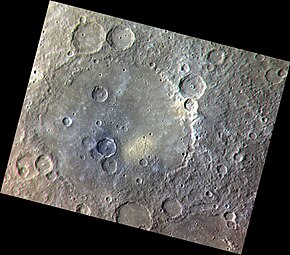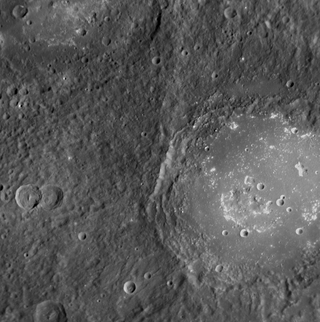
Lermontov is an impact crater on the planet Mercury. The crater is named after Mikhail Yuryevich Lermontov, a 19th-century Russian poet. The name was approved by the International Astronomical Union in 1976.

Matisse is an impact crater on the southern hemisphere of Mercury. Matisse takes its name from the French artist Henri Matisse, and it was named by the IAU in 1976.
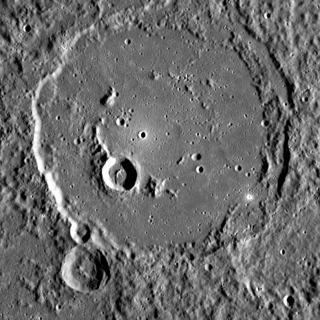
Polygnotus is a crater on Mercury, named by the IAU in 1976, after ancient Greek painter Polygnotus. The crater was first imaged by Mariner 10 in 1974.

Praxiteles is a crater on Mercury. It is one of 110 peak ring basins on Mercury.

Navoi is a crater on Mercury. It contains uncommon reddish material that indicates a different rock composition from its surroundings. Navoi also appears to have an irregularly shaped depression in its center. Such depressions have been seen elsewhere on Mercury, including within Praxiteles crater, and may indicate past volcanic activity.

Futabatei is a crater on Mercury. It has a diameter of 57 kilometers. Its name was adopted by the International Astronomical Union in 1976. Futabatei is named for the Japanese novelist Futabatei Shimei, who lived from 1864 to 1909. The crater was first imaged by Mariner 10 in 1974.

Machaut is a crater on Mercury. Its name was adopted by the International Astronomical Union in 1976. Machaut is named for the French composer and poet Guillaume de Machaut, who lived from 1300 to 1377. The crater was first imaged by Mariner 10 in 1974.

Mark Twain is a crater on Mercury. Its name was adopted by the International Astronomical Union (IAU) in 1976. Mark Twain is named for the American author Mark Twain, who lived from 1835 to 1910.
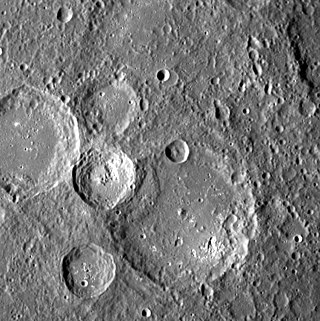
Mistral is a crater on Mercury. Its name was adopted by the International Astronomical Union (IAU) in 1976. Mistral is named for the Chilean poet Gabriela Mistral, who lived from 1889 to 1957.

Mussorgskij is a crater on Mercury. Its name was adopted by the International Astronomical Union (IAU) in 1979. Mussorgskij is named for the Russian composer Modest Mussorgsky, who lived from 1839 to 1881. The crater was first imaged by Mariner 10 in 1974.

Enheduanna is a crater on Mercury. It has a diameter of 105 kilometers. Its name was suggested by Gagan Toor from India in a naming contest which was eventually adopted by the International Astronomical Union (IAU) on 2015. Enheduanna is named for the Sumerian poet Enheduanna. The craters Carolan, Kulthum, Karsh, and Rivera were also named as part of the contest.

Pahinui is a crater on Mercury. Its name was adopted by the International Astronomical Union in 2016, after the Hawaiian musician, Charles Phillip Kahahawai "Gabby" Pahinui.
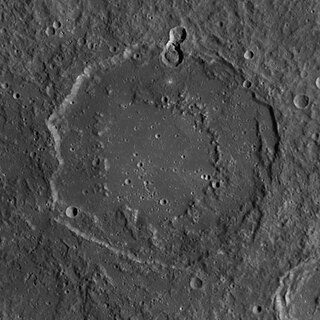
Nabokov is a crater on Mercury. Its name was adopted by the International Astronomical Union (IAU) on April 24, 2012. Nabokov is named for the Russian and American author Vladimir Nabokov.
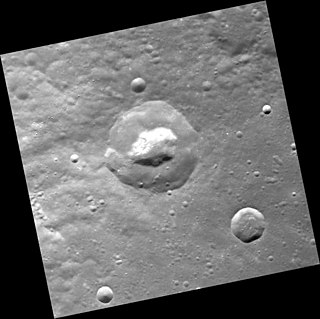
Namatjira is a crater on Mercury. It has a diameter of 34 kilometers. Its name was adopted by the International Astronomical Union (IAU) on September 25, 2015. Namatjira is named for the Australian aboriginal artist Albert Namatjira.

Rustaveli is a crater on Mercury. Its name was adopted by the International Astronomical Union in 2012, after the Georgian poet Shota Rustaveli.

Flaiano is a crater on Mercury. It has a diameter of 43 kilometres. Its name was adopted by the International Astronomical Union (IAU) on March 15, 2013. Flaiano is named for the Italian writer Ennio Flaiano. The crater was first imaged by Mariner 10 in 1974.

Donelaitis is a crater on Mercury. Its name was adopted by the International Astronomical Union (IAU) on May 15, 2013. Donelaitis is named for the Lithuanian poet Kristijonas Donelaitis.
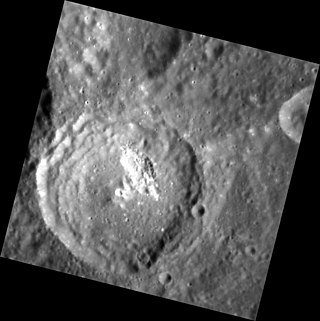
Veronese is a crater on Mercury. It has a diameter of 45 kilometres. Its name was adopted by the International Astronomical Union (IAU) on June 28, 2021. Veronese is named for the Italian painter Paolo Veronese.

Wen Tianxiang is a crater on Mercury. Its name was adopted by the International Astronomical Union (IAU) in June 2020, and it is named for Chinese writer and poet Wen Tianxiang.
